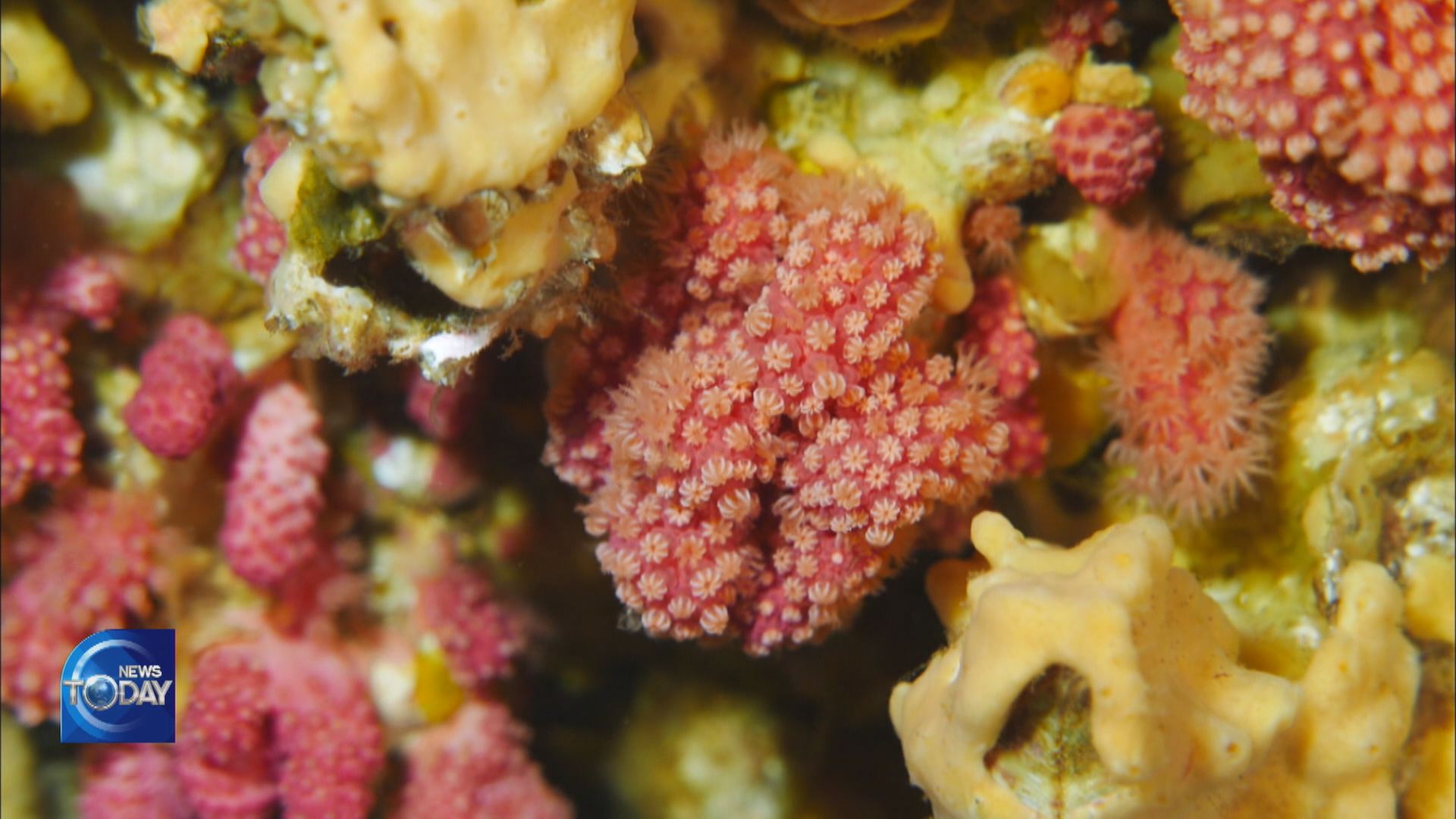RISING WATER TEMPERATURES BRING CHANGES
입력 2021.09.07 (15:12)
수정 2021.09.07 (16:48)
읽어주기 기능은 크롬기반의
브라우저에서만 사용하실 수 있습니다.
[Anchor Lead]
This summer was long and particularly hot. It seems those living on land were not alone in suffering from scorching heat. It was also getting warmer under the sea. In July, the water temperature in the East Sea hit a 40-year high. This rising water temperature is bringing rapid changes to the undersea landscape near the Korean Peninsula.
[Pkg]
After a three-hour sail southeast of Ulleung-do Island in the East Sea, the Dokdo islets come into view. The waters near Dokdo are where warm and cold currents meet. There's a wide variety of fish. But the scenery under the islets is changing considerably. Some 20 meters under the sea, rocks are covered with red creatures, which are as small as wild berries and have tiny tentacles on their round surface. These are sea strawberries, one of the soft corals found in the temperate zone. The species began spreading across the region near Dokdo a few year ago. Now, its habitat has increased by 15 percent, compared to 2016 when it was first spotted.
[Soundbite] Kim Sa-heung(Korea Marine-Bio Lab) : "The water is getting warmer. Stronger and more reproductive species are taking up more space."
This orange-colored fish is 12 centimeters long and looks like its wearing a fur hat on its head. They usually live in warm regions like Taiwan. The fish was newly named East Sea moss fringehead after it was first found in the waters off Korea. Even rare subtropical fish, which live in areas like Indonesia and Jeju, are sometimes spotted here. For example, coral fish, a subtropical species and a local specialty from Jeju. have already become a local fixture in the Dokdo region. Their number has jumped more than ten fold over the past decade. Other species living in warm areas, like lionfish, sea bass and red spotted groupers, have also settled in the eastern waters.
[Soundbite] Kim Young-nam(Korea Marine Environment Management Corporation) : "The changes in water temperature might have been caused by the influx of warm water. But it also indicates that Korea’s oceans are getting warmer, including the current."
Summer temperatures in the waters off Dokdo have risen by some 2.2 degrees over the past decade. Some 60 percent of the fish observed near the islets belong to species living in warm regions. That's up 15 percent from five years ago. South Korea’s waters are getting warmer due to climate change and sea creatures from warm zones are expanding their presence to dominate the marine eco-system.
This summer was long and particularly hot. It seems those living on land were not alone in suffering from scorching heat. It was also getting warmer under the sea. In July, the water temperature in the East Sea hit a 40-year high. This rising water temperature is bringing rapid changes to the undersea landscape near the Korean Peninsula.
[Pkg]
After a three-hour sail southeast of Ulleung-do Island in the East Sea, the Dokdo islets come into view. The waters near Dokdo are where warm and cold currents meet. There's a wide variety of fish. But the scenery under the islets is changing considerably. Some 20 meters under the sea, rocks are covered with red creatures, which are as small as wild berries and have tiny tentacles on their round surface. These are sea strawberries, one of the soft corals found in the temperate zone. The species began spreading across the region near Dokdo a few year ago. Now, its habitat has increased by 15 percent, compared to 2016 when it was first spotted.
[Soundbite] Kim Sa-heung(Korea Marine-Bio Lab) : "The water is getting warmer. Stronger and more reproductive species are taking up more space."
This orange-colored fish is 12 centimeters long and looks like its wearing a fur hat on its head. They usually live in warm regions like Taiwan. The fish was newly named East Sea moss fringehead after it was first found in the waters off Korea. Even rare subtropical fish, which live in areas like Indonesia and Jeju, are sometimes spotted here. For example, coral fish, a subtropical species and a local specialty from Jeju. have already become a local fixture in the Dokdo region. Their number has jumped more than ten fold over the past decade. Other species living in warm areas, like lionfish, sea bass and red spotted groupers, have also settled in the eastern waters.
[Soundbite] Kim Young-nam(Korea Marine Environment Management Corporation) : "The changes in water temperature might have been caused by the influx of warm water. But it also indicates that Korea’s oceans are getting warmer, including the current."
Summer temperatures in the waters off Dokdo have risen by some 2.2 degrees over the past decade. Some 60 percent of the fish observed near the islets belong to species living in warm regions. That's up 15 percent from five years ago. South Korea’s waters are getting warmer due to climate change and sea creatures from warm zones are expanding their presence to dominate the marine eco-system.
■ 제보하기
▷ 카카오톡 : 'KBS제보' 검색, 채널 추가
▷ 전화 : 02-781-1234, 4444
▷ 이메일 : kbs1234@kbs.co.kr
▷ 유튜브, 네이버, 카카오에서도 KBS뉴스를 구독해주세요!
- RISING WATER TEMPERATURES BRING CHANGES
-
- 입력 2021-09-07 15:12:01
- 수정2021-09-07 16:48:09

[Anchor Lead]
This summer was long and particularly hot. It seems those living on land were not alone in suffering from scorching heat. It was also getting warmer under the sea. In July, the water temperature in the East Sea hit a 40-year high. This rising water temperature is bringing rapid changes to the undersea landscape near the Korean Peninsula.
[Pkg]
After a three-hour sail southeast of Ulleung-do Island in the East Sea, the Dokdo islets come into view. The waters near Dokdo are where warm and cold currents meet. There's a wide variety of fish. But the scenery under the islets is changing considerably. Some 20 meters under the sea, rocks are covered with red creatures, which are as small as wild berries and have tiny tentacles on their round surface. These are sea strawberries, one of the soft corals found in the temperate zone. The species began spreading across the region near Dokdo a few year ago. Now, its habitat has increased by 15 percent, compared to 2016 when it was first spotted.
[Soundbite] Kim Sa-heung(Korea Marine-Bio Lab) : "The water is getting warmer. Stronger and more reproductive species are taking up more space."
This orange-colored fish is 12 centimeters long and looks like its wearing a fur hat on its head. They usually live in warm regions like Taiwan. The fish was newly named East Sea moss fringehead after it was first found in the waters off Korea. Even rare subtropical fish, which live in areas like Indonesia and Jeju, are sometimes spotted here. For example, coral fish, a subtropical species and a local specialty from Jeju. have already become a local fixture in the Dokdo region. Their number has jumped more than ten fold over the past decade. Other species living in warm areas, like lionfish, sea bass and red spotted groupers, have also settled in the eastern waters.
[Soundbite] Kim Young-nam(Korea Marine Environment Management Corporation) : "The changes in water temperature might have been caused by the influx of warm water. But it also indicates that Korea’s oceans are getting warmer, including the current."
Summer temperatures in the waters off Dokdo have risen by some 2.2 degrees over the past decade. Some 60 percent of the fish observed near the islets belong to species living in warm regions. That's up 15 percent from five years ago. South Korea’s waters are getting warmer due to climate change and sea creatures from warm zones are expanding their presence to dominate the marine eco-system.
This summer was long and particularly hot. It seems those living on land were not alone in suffering from scorching heat. It was also getting warmer under the sea. In July, the water temperature in the East Sea hit a 40-year high. This rising water temperature is bringing rapid changes to the undersea landscape near the Korean Peninsula.
[Pkg]
After a three-hour sail southeast of Ulleung-do Island in the East Sea, the Dokdo islets come into view. The waters near Dokdo are where warm and cold currents meet. There's a wide variety of fish. But the scenery under the islets is changing considerably. Some 20 meters under the sea, rocks are covered with red creatures, which are as small as wild berries and have tiny tentacles on their round surface. These are sea strawberries, one of the soft corals found in the temperate zone. The species began spreading across the region near Dokdo a few year ago. Now, its habitat has increased by 15 percent, compared to 2016 when it was first spotted.
[Soundbite] Kim Sa-heung(Korea Marine-Bio Lab) : "The water is getting warmer. Stronger and more reproductive species are taking up more space."
This orange-colored fish is 12 centimeters long and looks like its wearing a fur hat on its head. They usually live in warm regions like Taiwan. The fish was newly named East Sea moss fringehead after it was first found in the waters off Korea. Even rare subtropical fish, which live in areas like Indonesia and Jeju, are sometimes spotted here. For example, coral fish, a subtropical species and a local specialty from Jeju. have already become a local fixture in the Dokdo region. Their number has jumped more than ten fold over the past decade. Other species living in warm areas, like lionfish, sea bass and red spotted groupers, have also settled in the eastern waters.
[Soundbite] Kim Young-nam(Korea Marine Environment Management Corporation) : "The changes in water temperature might have been caused by the influx of warm water. But it also indicates that Korea’s oceans are getting warmer, including the current."
Summer temperatures in the waters off Dokdo have risen by some 2.2 degrees over the past decade. Some 60 percent of the fish observed near the islets belong to species living in warm regions. That's up 15 percent from five years ago. South Korea’s waters are getting warmer due to climate change and sea creatures from warm zones are expanding their presence to dominate the marine eco-system.
이 기사가 좋으셨다면
-
좋아요
0
-
응원해요
0
-
후속 원해요
0














![[단독] 도이치 주포 “김건희, 내 덕에 떼돈 벌어…22억 원 주문”](/data/news/2025/07/03/20250703_KpuU43.png)
![[단독] “쪽지 얼핏 봤다, 안 받았다”더니…CCTV에선 문건 챙긴 이상민](/data/news/2025/07/03/20250703_Lv3LjI.png)

이 기사에 대한 의견을 남겨주세요.